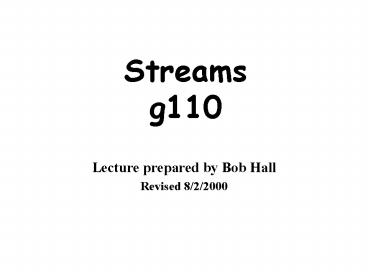Streams g110 PowerPoint PPT Presentation
1 / 33
Title: Streams g110
1
Streamsg110
- Lecture prepared by Bob Hall
- Revised 8/2/2000
2
Topics To Be Covered
- Why study streams?
- Floods
- Drainage basins
- Streams as component of hydrologic cycle
- Masters of adjustment
- Stream variables
- Stream profile
- Masters of adjustment
- Channel patterns
- Meandering
- Braided
- Flood plain formation
- Lateral accretion
- Vertical accretion
- Stream terraces
3
StreamsWhy we need to know about themTheir
shifty behavior
- Flowing water the dominant agent in shaping the
landscape. - Rivers are the source of most marine sediments.
- Absolutely essential use as water source.
- Almost as important in transportation, generating
electricity, recreation - In flood, they are our greatest life-taking
geologic hazard.
4
White River, Indianapolis1999
5
Flood!!
6
The Drainage Basin (Watershed)
7
United States Drainage Basins
8
Streams in the Context ofthe Hydrologic Cycle
9
Concept of Discharge
Q A x V
Jm slide15
10
Concept of the Hydrograph
Jm slide 16
11
Quiz
- What would the hydrographs look like for a
stream draining the same watershed under the
following conditions - Under a forest cover.
- Planted to crops
- Urbanized
12
Streams as Masters of Adjustment
- Stream Variables
- Stream Profiles and Base Level
- Stream-Channel Patterns
13
Stream Variables
- Independent
- Discharge (Q)
- Sediment load
- Dependent
- Width (W)
- Depth (D)
- Velocity (V)
The interrelationships between variables is
expressed as the discharge equation Q W x D x
V As Q changes, changes must also occur in W,
D, and V. Examples flood, withdrawal of
irrigation water.
14
Stream Variables (cont.)
- Solution By the continuity equation, Q W x D
x V, - An increase in W will force a decrease in depth
and/or velocity. - If change is in depth, the stream will be only ½
as wide
- Problem If discharge remains the same through 2
stream cross sections, but the second is twice as
wide as the first, what changes in variables will
occur?
15
Stream Profiles
- Transverse trapezoids to troughs to Vs
- Longitudinal concave upward
- Smooth an equilibrium profile stream said
to be graded.
knickpoint
A profile with knickpoints is not in equilibrium.
16
Stream Profiles (cont.)
- Problem A landslide adds much material to the
load carried by the stream. How will the stream
respond?
- Solution To handle the extra load, the stream
must increase velocity. - Steepening the gradient is one way.
- How could the stream adjust using the continuity
equation?
17
Base Level
- Lowest level to which a stream can erode.
- Ultimate b.l. sea level
- Temporary b.l.
- lakes
- tributary junctions
- resistant rocks in channel
What happens to a stream profile if base level
falls? If it rises?
18
Longitudinal Profile and Base Level
19
Channel Patterns
- Braided multiple channels, indiv. ones may
meander.
- Meandering series of bends, usually as single
channel
20
Meandering Stream
21
Stream Meanders
22
Meander Cutoff
23
Entrenched Meanders
24
Braided Channels
- Jm slide 27
25
Meandering vs. Braided Patterns
- Meandering
- Less total load
- Finer-grained load
- Cohesive banks
- Braided
- More total load
- Coarser-grained
- Non-cohesive banks
26
Meandering vs Braided Streams
- Problem A stream flows with a meandering pattern
through a stretch, then flows with a braided
pattern for another stretch, then returns to
meandering once again. Why?
- Braided The stream bed materials change from fine
to coarse to fine.
27
Stream Behavior
28
Adjustments of Longitudinal Profile
Jm slide 21
29
Flood Plain Formation by Lateral Accretion
30
Flood Plain Formation by Vertical Accretion
31
Stream TerracesHow do they form?
- Abandoned flood
- plains
- Another shift in stream behavior.
32
Terms Used in Studying Streams
- Base level
- Discharge
- Drainage basin
- Entrenched meander
- Graded stream
- Hydrograph
- Knickpoint
- Longitudinal profile
- Meander cutoff
- Stream-channel pattern
- Stream variable
- Temporary base level
- Transverse profile
- Ultimate base level
- Watershed
33
Student Responsibilities on Streams
- What is a drainage basin? How are streams part
of the hydrologic cycle? Explain how streams are
masters of adjustmentwith at least 4 examples
include the concepts of stream variables, stream
profileless and base level, channel patterns, and
stream behavior. How do flood plains form? How
do stream terraces form?

